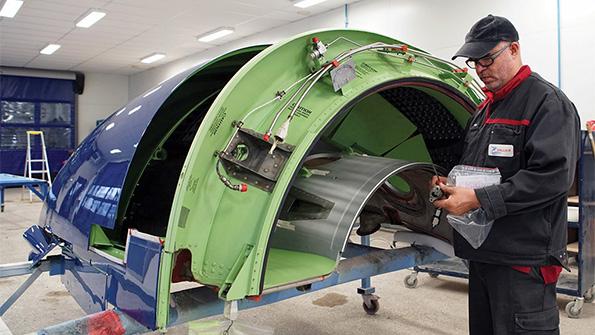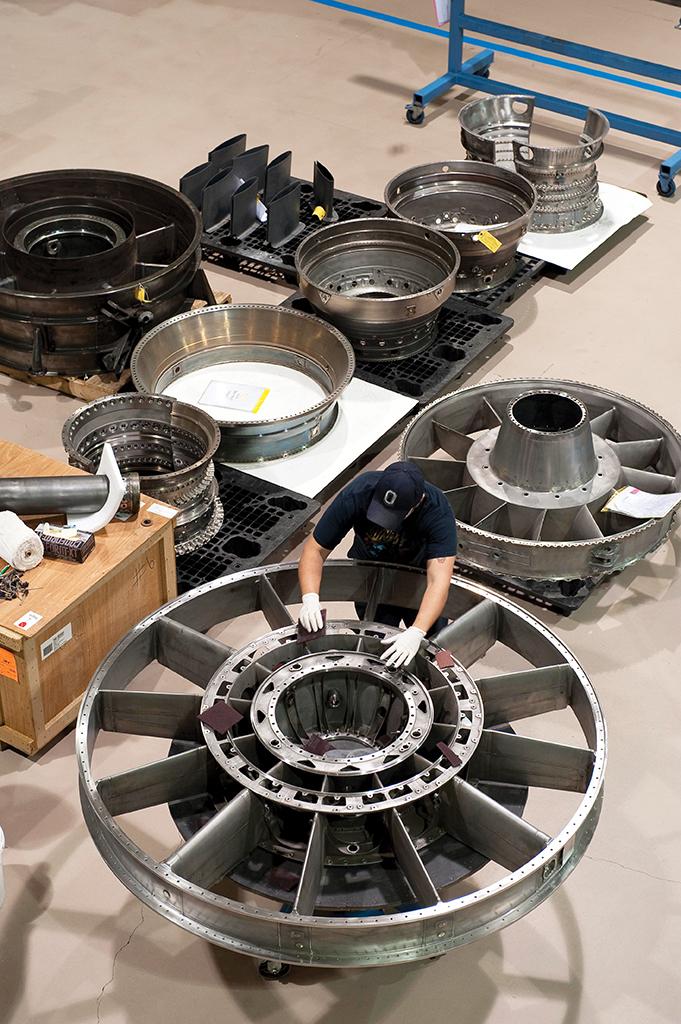
With global air travel severely disrupted by the COVID-19 pandemic, the component MRO market is expected to take a hit, at least in the short term. Yet suppliers of engine and aerostructure components maintain that demand is generally holding steady despite projected decreases in MRO spending and some pricing pressure.
Prior to the pandemic, the component MRO market for 2020 was estimated at $17.5 billion. However, now a decrease of $5.4-8.3 billion is projected in component MRO spending over three years, according to Aviation Week Commercial Fleet and MRO Forecast data.
“The effects of the COVID-19 pandemic are likely to be felt for at least 18-24 months; perhaps even longer as the dramatic knock-on effects resonate through economies, airlines and MROs,” says Brian Kough, Aviation Week’s senior director of forecasts and aerospace insights.

The International Air Transport Association (IATA) recently projected an overall air traffic decline of 38% in 2020, which would “likely be the floor” for any corresponding decline in component MRO. “Since many components are maintained ‘on condition,’ their maintenance demand is directly proportional to fleet utilization,” says Adam Guthorn, a director of the Alton Aviation consultancy in New York.
Guthorn says that with a significant portion of the fleet parked, and airlines throughout the world focused on cash conservation, increased aircraft retirements and material availability, along with cannibalization and borrowing of components from stored aircraft are expected to reduce demand for MRO services in the near term.
Component MRO will face competition from surplus parts and inventory “burn-down,” notes Richard Brown, managing director of the NAVEO consultancy in London. At the same time, midlife aircraft—those 12-17 years old—will become yet another competitive source of supply in a component MRO market that he predicts could be down 25-30% this year.
“While the drop in air travel demand will encourage airlines to retire aircraft in their sunset or end-of-life phase, we will start seeing the premature retirement of midlife aircraft that are most likely to require engine shop visits, as well as airframe and component maintenance,” Brown says. “That will likely mean more availability of used serviceable material (USM) as retirements increase and more aircraft are parked.” He notes that airline capacity could be down 70-80% in April 2020.
“While more USM will benefit the airlines, it could also challenge the USM traders who might see an excess supply of some part types and pricing pressure on inventory previously thought to be valued higher,” Brown cautions.
Pricing Dynamics
USM can be characterized as a spot market that will fluctuate with demand, says Horacio Repetto, general manager of GE Aviation Materials (GEAM), a major USM supplier. “As many MROs are currently slowing down and furloughing employees, the USM market dynamic is that demand will follow that trend,” he says.
Those factors, Repetto explains, will result in sellers seeking to align supply with demand, rather than sell when demand is low in lieu of preserving value. “Cash pressure dynamics could shift that behavior, and it will be important to monitor the market leaders,” he remarks.
Repetto predicts the USM market should continue to align with global demand for shop visits and the resulting actions on MRO capacity. “There has been no substantial change to the USM market, although we have seen some brokers being cautious with buying inventory that may require being held longer in order to find demand,” he says.
Although it is difficult to say when traffic will recover, Repetto cites a report from IATA that predicts a return to 2019 traffic levels by the end of 2020. That, he says, will mean stored aircraft will be required to meet demand. “For the USM market, it will be important to monitor closely the actions that aircraft and engine operators, as well as owners, take with respect to utilization and future shop visits,” Repetto notes.
Component traders and leasing companies are taking the long view, confident that the downturn in MRO will not be long-lasting.
“For the commercial aircraft engine and airframe component market, all the expected trends have shifted with the focus on COVID-19,” says Anca Mihalache, vice president of engine trading for APOC Aviation, a Netherlands-based component leasing, trading and aircraft part-out company. “Over the last three years, there had been a steady increase in narrowbody aircraft engine sale prices and lease rates, which were expected to continue or remain at the same level. Now we can see prices slightly decreasing.”
Mihalache points out specifically lease rates for engines powering the Boeing 737NG and the Airbus A320neo, predicting that they might not return to what they were only a few months ago. Even so, she expects those engines will still have a high value after the pandemic passes.
The CFM56 could, in fact, be a bright spot. Mihalache cites the protracted Boeing 737 MAX grounding as the reason behind ongoing demand for CFM56 components, with those for the CFM56-7B generating the highest pricing increase. This has also led to higher prices on CFM56-3C1 material, but on a lower scale, she says. Those engines, respectively, power the 737NG and 737-400, many of which Mihalache says have been converted from passenger to cargo aircraft.
“The cargo operators are now the ones generating high demand. That’s why I think the narrowbodies—the Boeing Classic/NG and Airbus A320, will always do well,” Mihalache states.

As for the availability of USM, Mihalache believes that material shortages will continue. “Even if some airlines do not survive, their aircraft will be redirected to other operators,” she says. “Not many will be retired, so I expect the material shortage on the CFM56 and V2500 engine types to remain.”
Jasper van den Boogaard, APOC Aviation’s vice president of airframe acquisition and trading, predicts demand for airframe components will remain steady. Even if aircraft are grounded, he asserts, they will still require calendar-driven maintenance checks and gear overhauls. “At APOC, we focus on two main asset types—the A320 family and the 737NG series, which make up over half the world’s fleet,” says van den Boogaard, who is also an International Society of Transport Aircraft Traders (ISTAT) certified appraiser. “Historically, these have always recovered first after any [adverse] market influence.”
Karolis Jurkevicius, APOC Aviation’s vice president of landing gear trading and leasing, reports that depending on landing gear type, there has been a 5-10% decrease in landing gear lease rates, with the likelihood of a higher percentage drop due to an increase in assets available now—given the COVID-19 situation. He cautions that while demand should recover soon, prices will stay at a lower level for a longer period. “I’m sure that prices for some types of landing gear will come back to normal levels, as demand will still be high. However, others will remain low and never recover,” Jurkevicius says.
As the COVID-19 crisis abates, there will be “a massive upsurge in demand” for components, predicts Martin Ward, director of material management and supply chain for Vallair, a Luxembourg-headquartered aircraft leasing, trading, MRO and teardown company.
In fact, Ward reports that “progressive companies” already are buying up packages of spares from their providers for leading commercial airliner types, at bargain prices, as airlines look for ways to resume flying as fast as they can. “Aircraft in storage will have been subjected to daily/weekly checks to ensure everything is still operational so engineers and maintenance teams will know exactly what their needs will be,” he stresses, adding that packages of spares continue to be offered to Vallair. “If those packages come with the right traceability and paperwork, and they suit our own fleet of leased aircraft, then we’re interested.”
Vallair has observed ongoing interest in CFM56-5A engine parts, which “seems to go against perceived wisdom,” Ward says. “It appears that brokers want to fill up their stock.”
Challenges
One of the major challenges in the narrowbody aircraft engine and airframe component market is a scarcity of life limited parts (LLP), says Justin Blockley, commercial director of Bii.aero, located near London.
“LLPs for narrowbodies have steadily increased in demand and pricing since the problems with the 737 MAX,” says Blockley, whose company is a components and services provider specializing in the 737NG, 747, 757, 767 and Bombardier regional jet families. “This is the same for CFM56-5A material, as airlines are looking to utilize the existing fleet longer. Simply, demand has outstripped supply caused by capacity constraints of new aircraft deliveries.”
He also notes that aircraft retirements will continue to have a bearing on component MRO, but given current conditions, decisions are fluid, with “retirement plans being re-written almost monthly,” he notes.
“The coronavirus is hitting the pause button on both new aircraft production as well as demand,” Blockley says. “Those airlines with weak balance sheets are likely to move more and more to leasing options in order to protect cash and move large assets to a variable cost model.”
Asked if the new generation of Airbus products, and the eventual return of the 737 MAX are likely to push many more aging aircraft into retirement and affect the component repair market, Blockley says it may be too soon to tell. “But I think that aircraft which have already been through a heavy check will definitely complete their life cycle,” he says.
He also states that with fuel prices “the lowest in living memory,” the economics of the new low-fuel-burn fleets, compared to their large capital acquisition costs, throw the investment algorithm into serious question. “This, coupled with the huge backlog in engine MRO, means it is likely that the retirement age will take several years to return to the levels once seen—about 15 years—especially on narrowbody aircraft. It could, in fact, go as high as 18,” he predicts.
One example of engine MRO demand Blockley cites is the CFM56-5, which he says is “still in massive demand” for both overhaul and teardown as operators look to replace LLPs with partly run components in an effort to match engine life with postponed airframe retirements.
He predicts that OEMs will have a great presence in the MRO market after the pandemic, but he thinks this will be countered by an increase in parts manufacturing approval (PMA) and designated engineering representative (DER) options, “as operators refuse to be bullied into accepting the OEM pricing structure,” says Blockley.
OEM Growth
Alton Aviation Consultancy’s Adam Guthorn says 60-70% of the component repair market is held by airlines and independent MROs, with the component and system OEMs holding the remainder. “I would expect that the OEMs could gain another 5% of that over the next decade, through new contract wins on the newest-generation aircraft types,” he says. “That is where the OEMs hold a negotiating advantage at point of sale; the independent repair market is less developed, and surplus material is not yet a major factor.”
According to Rick Stine, president of StandardAero’s components, helicopters and accessories division, OEMs will be taking a greater position in component MRO but largely through affiliated networks.
“In the past, the legacy engines tended to have a more open structure around what repairs a third-party shop could perform relative to MRO,” Stine explains. “Today’s newer-generation engines require an MRO provider to be part of the authorized OEM network. Only then can it get access to repairs and technical data.”
He stresses that even with such authorization the availability of data is still limited and at times requires a third-party MRO to pay additional fees or royalties to qualify repair capabilities. “This new reality will be a major game changer as OEMs continue to take more control of the MRO market,” he says.
Coupled with that, Stine predicts there will be a disinclination among the OEMs to continue doing touch labor. “I see the OEMs not wanting to turn wrenches in the future,” he says. “I think this plays into how they are approaching engine component repair, which is to develop networks they can use to support their fleet. The MRO facility’s ability to match its skills and expertise to the OEM’s needs will be critical to supporting them.”

